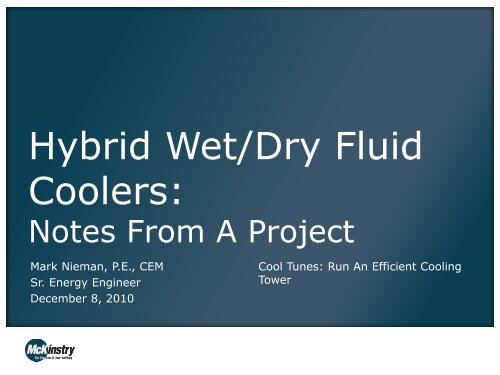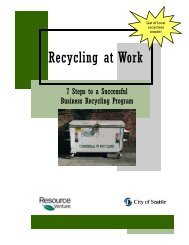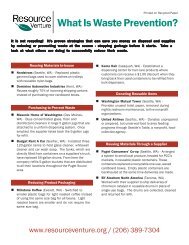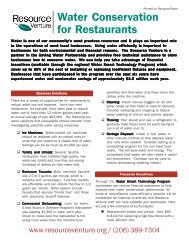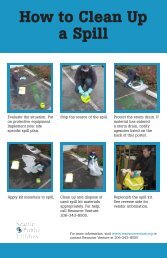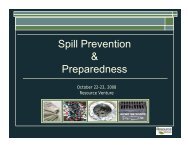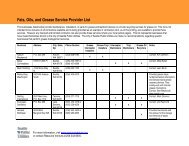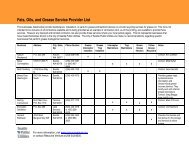Hybrid Wet/Dry Fluid Coolers - Resource Venture
Hybrid Wet/Dry Fluid Coolers - Resource Venture
Hybrid Wet/Dry Fluid Coolers - Resource Venture
You also want an ePaper? Increase the reach of your titles
YUMPU automatically turns print PDFs into web optimized ePapers that Google loves.
<strong>Hybrid</strong> <strong>Wet</strong>/<strong>Dry</strong> <strong>Fluid</strong><br />
<strong>Coolers</strong>:<br />
Notes From A Project<br />
Mark Nieman, P.E., CEM<br />
Sr. Energy Engineer<br />
December 8, 2010<br />
Cool Tunes: Run An Efficient Cooling<br />
Tower
Original Goals of Project<br />
Save water<br />
Minimize plume hitting the building<br />
Add ability to do waterside economizer cooling at<br />
computer room units<br />
Add redundancy to cooling system – Two fans on<br />
new tower, two condenser water pumps, added<br />
condenser water loop. Has ability to go back to<br />
the original<br />
Electrical savings<br />
Chemical savings
Original Basis of Design<br />
Up to 50% water savings<br />
Space and weight savings vs. dry<br />
coolers only<br />
Four or five dry fluid coolers<br />
would be required, each with 10<br />
fans and a footprint of 12’-6” x<br />
8’-1” each<br />
Water-side Economizer available vs.<br />
dry coolers<br />
Final footprint at 28’ x 8’<br />
Electrical Savings<br />
Non-chemical tower treatment
eQUEST Calculations for Electricity <strong>Wet</strong>-<strong>Dry</strong><br />
Operation<br />
In eQUEST, simulated a dry tower as first stage<br />
and a wet tower as second stage
eQUEST Staging of <strong>Wet</strong>-<strong>Dry</strong> Operation<br />
<strong>Dry</strong> tower as first stage and a wet tower as<br />
second stage
Raw Hourly Calculations for <strong>Wet</strong>-<strong>Dry</strong> Operation<br />
Sample output showing <strong>Dry</strong> Cooler & <strong>Fluid</strong> Cooler cycling on<br />
and off depending on OAT <strong>Dry</strong>/<strong>Wet</strong> Bulb<br />
C:\Program Files\eQUEST 3-62\Projects\SMT\SMT-<strong>Dry</strong>-<strong>Wet</strong> FC - Baseline Design<br />
Simulated: 2007-Sep-27 14:27:38<br />
CSV Written: 2007-Sep-28 10:24:38<br />
eQUEST 3.62.5760<br />
CWT Report<br />
OAT <strong>Dry</strong> Cooler Block <strong>Fluid</strong> Cooler Block<br />
Global HEAT-REJECTION HEAT-REJECTION<br />
<strong>Dry</strong> Cooler <strong>Fluid</strong> Cooler<br />
Var 3 Var 4 Var 15 Var 24 Var 15 Var 24 Var 28<br />
Outside Outside Number of Fan<br />
wet-bulb dry-bulb cells electrical<br />
Month Day Hour temp (F) temp (F) operating power<br />
5 5 7 53 57 1 1.8<br />
5 5 8 54 60 1 2.1<br />
5 5 9 56 60 1 2.2<br />
5 5 10 57 64 1 5.6<br />
5 5 11 58 66 1 1.6<br />
5 5 12 61 72 0 -<br />
5 5 13 62 74 0 -<br />
5 5 14 62 76 0 -<br />
5 5 15 63 76 0 -<br />
5 5 16 63 77 0 -<br />
5 5 17 63 73 0 -<br />
5 5 18 63 74 0 -<br />
5 5 19 60 69 1 2.4<br />
5 5 20 55 65 1 6.3<br />
5 5 21 55 66 1 1.5<br />
5 5 22 55 64 1 4.2<br />
5 5 23 55 62 1 2.6<br />
Number<br />
of cells<br />
operating<br />
-<br />
-<br />
-<br />
-<br />
1<br />
1<br />
1<br />
1<br />
1<br />
1<br />
1<br />
1<br />
1<br />
-<br />
1<br />
-<br />
-<br />
Fan<br />
electrical<br />
power<br />
-<br />
-<br />
-<br />
-<br />
1.5<br />
2.9<br />
3.3<br />
3.3<br />
3.4<br />
3.4<br />
3.4<br />
3.4<br />
2.1<br />
-<br />
1.0<br />
-<br />
-<br />
Spray<br />
Pump<br />
-<br />
-<br />
-<br />
-<br />
2.6<br />
2.6<br />
2.6<br />
2.6<br />
2.6<br />
2.6<br />
2.6<br />
2.6<br />
2.6<br />
-<br />
2.6<br />
-<br />
-
Project Target Savings<br />
Projected Savings<br />
kWh kWh ($) kW/Month<br />
TARGET ENERGY CONSUMPTION SAVINGS *** GUARANTEE<br />
Electricity Water Sewer Other Total<br />
Months of<br />
kW<br />
Savings<br />
kW ($) CCF<br />
CCF ($) CCF<br />
CCF ($) $ Utility ($)<br />
166,241 $8,861 23.7 12 $228 946 $2,669 946 $7,051 $2,489 $21,297
Problems Encountered<br />
New Sage panel programming<br />
Operation of two fans off one VFD<br />
How often the wet-side fan engaged compared to<br />
the dry-side<br />
Driven by condenser water setpoint<br />
Fixed by condenser water reset schedule
Then vs. Now<br />
Then<br />
Old tower design<br />
Coil from Italy (pressure<br />
rating issues and damage<br />
in shipment)<br />
Sage Generation 1<br />
LARGE footprint (two<br />
towers!)
New Tower Improvement<br />
Now<br />
On 3rd Generation SAGE<br />
Panel Programming<br />
Smaller footprint<br />
One fan instead of two<br />
for smaller tower lines<br />
(similar design to<br />
induced draft fan<br />
towers)<br />
Spiral fins on elliptical<br />
tubes (3 fpi)<br />
One VFD per motor
New Two Tower Options<br />
<strong>Dry</strong> or wet operation<br />
<strong>Hybrid</strong> operation: dry, dry/wet, wet operation<br />
modes
Challenges<br />
Not many left!<br />
More expensive than conventional towers<br />
Heavier equipment vs. dry cooler (similar<br />
problem with other fluid coolers)<br />
Depending on selection, usually hybrid towers are now<br />
smaller and lighter than a wet-only tower of the same<br />
capacity.<br />
Developing technology (already on 3 rd generation<br />
controls)
Benefits<br />
Less water consumption (water & sewer) =<br />
money saved<br />
In general, smaller footprint vs. other wet towers<br />
Less plume potential<br />
Manufacturer software improving to determine<br />
performance<br />
Increased evaporative capacity<br />
Less horsepower than first generation<br />
Increased dry capacity<br />
Fan savings in evaporative mode<br />
Most water efficient system type available
Questions?<br />
Mark Nieman, P.E., CEM<br />
McKinstry Co.<br />
(206) 832-8152<br />
markn@mckinstry.com


